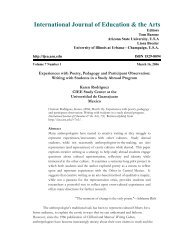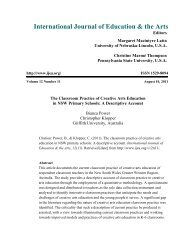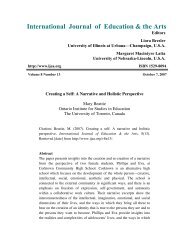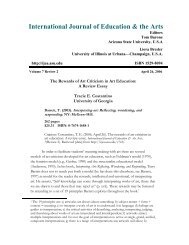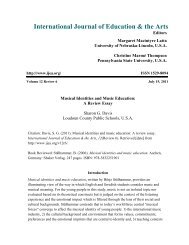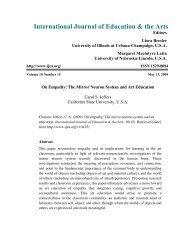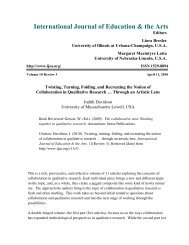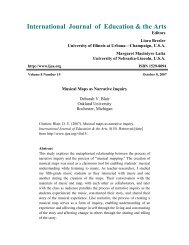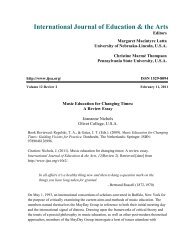Drawing with light and clay: Teaching and learning in the art studio ...
Drawing with light and clay: Teaching and learning in the art studio ...
Drawing with light and clay: Teaching and learning in the art studio ...
Create successful ePaper yourself
Turn your PDF publications into a flip-book with our unique Google optimized e-Paper software.
IJEA http://ijea.asu.edu 14<br />
should be used. Students would <strong>the</strong>n be required to problem-solve: <strong>the</strong>re are many<br />
possible acceptable solutions. Students may chose to create an object that is designed to<br />
conta<strong>in</strong> a p<strong>art</strong>icular substance or for a p<strong>art</strong>icular person. They may use any surface<br />
decoration or method that would not <strong>in</strong>terfere <strong>with</strong> <strong>the</strong> use <strong>and</strong> clean<strong>in</strong>g of <strong>the</strong> vessel<br />
while also communicat<strong>in</strong>g <strong>in</strong>formation about <strong>the</strong> functionality of <strong>the</strong> vessel. Students may<br />
decide to make a h<strong>and</strong>le or not, <strong>and</strong> <strong>the</strong> shape, size <strong>and</strong> texture of <strong>the</strong> object might be left<br />
open. These choices can be highly motivat<strong>in</strong>g because this is where <strong>in</strong>dividuals can be<br />
creative. The restrictions become a puzzle to solve, giv<strong>in</strong>g structure to <strong>the</strong> <strong>learn<strong>in</strong>g</strong>. As<br />
learners ga<strong>in</strong> expertise, <strong>the</strong>y take over more <strong>and</strong> more of <strong>the</strong> creative problem-f<strong>in</strong>d<strong>in</strong>g<br />
process, <strong>the</strong>reby mov<strong>in</strong>g <strong>the</strong>m towards more <strong>art</strong>istic autonomy.<br />
Similarly <strong>in</strong> photography, a teacher might ask students to use a p<strong>art</strong>icular k<strong>in</strong>d of film <strong>and</strong><br />
learn how to develop it a p<strong>art</strong>icular way, but <strong>the</strong> content might have a very open <strong>the</strong>me.<br />
These open- ended <strong>the</strong>mes, such as My Neighborhood or The Last Chance can allow for<br />
<strong>the</strong> creation of imagery of a highly personal nature. This content may have great mean<strong>in</strong>g<br />
to <strong>the</strong> students, help<strong>in</strong>g to motivate <strong>the</strong>m to master <strong>the</strong> technical skills needed to realize<br />
<strong>the</strong>ir ideas <strong>and</strong> to triumph over failures or frustrations that are p<strong>art</strong> of <strong>the</strong> process of<br />
atta<strong>in</strong><strong>in</strong>g mastery.<br />
These examples of activities that balance freedom <strong>and</strong> structure, contrast sharply <strong>with</strong><br />
curricula characterized by activities where <strong>the</strong>re is one s<strong>in</strong>gle ‘correct’ response. Faced<br />
<strong>with</strong> this sort of limit<strong>in</strong>g curricula, students often ask, “Is this right Is this what you<br />
want me to do” or alternatively <strong>the</strong>y bl<strong>in</strong>dly complete <strong>the</strong> assignment as quickly <strong>and</strong><br />
pa<strong>in</strong>lessly as possible, forgett<strong>in</strong>g what <strong>the</strong>y did soon after <strong>the</strong>y have completed <strong>the</strong> tasks<br />
(Albertson, 2001; Davidson, 2000). Because <strong>the</strong>se sorts of activities leave little room for<br />
personal <strong>in</strong>put or expression, many students simply go through <strong>the</strong> motions, or as Robert<br />
Fried (1995) suggests, <strong>the</strong>y become adept at “play<strong>in</strong>g <strong>the</strong> game of school”(p. 189).<br />
Play<strong>in</strong>g this game does not result <strong>in</strong> engagement <strong>in</strong> or excitement about <strong>the</strong> subject matter<br />
or <strong>the</strong> <strong>learn<strong>in</strong>g</strong> process, <strong>and</strong> it is exactly <strong>the</strong> sort of resistance that could be dim<strong>in</strong>ished <strong>in</strong><br />
all school environments by study<strong>in</strong>g <strong>the</strong> ways that students become connected to <strong>learn<strong>in</strong>g</strong><br />
<strong>in</strong> <strong>the</strong> <strong>art</strong> <strong>studio</strong>.<br />
Permission to Fail<br />
All <strong>art</strong>s are risk-tak<strong>in</strong>g adventures, <strong>and</strong> failure <strong>in</strong> photography <strong>and</strong> <strong>the</strong> ceramic <strong>art</strong>s is a<br />
given. Whe<strong>the</strong>r it has more to do <strong>with</strong> <strong>the</strong> <strong>learn<strong>in</strong>g</strong> relationships described above or<br />
because of <strong>the</strong> technical steps that students must master to move beyond <strong>the</strong> most basic<br />
results, we have found that students study<strong>in</strong>g photography <strong>and</strong> ceramics are more will<strong>in</strong>g<br />
to take risks, try th<strong>in</strong>gs that <strong>the</strong>y don’t already know, fail sometimes, <strong>and</strong> yet try aga<strong>in</strong>.<br />
This was a p<strong>art</strong>icularly important <strong>the</strong>me <strong>in</strong> Albertson’s (2001) study. All of <strong>the</strong>




